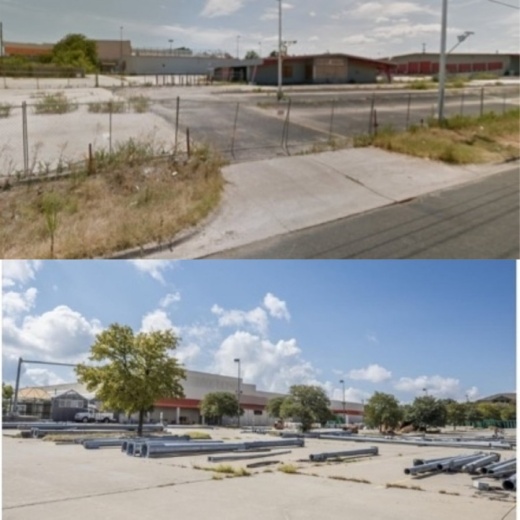City Council unanimously agreed July 29 to find a developer who can turn the troubled, city-owned property into a lively, mixed-use community center that celebrates the Northeast Austin neighborhood and the culture that surrounds it.
The property, located in what was one of the city’s first freedmen’s communities at the turn of the 20th century, has housed the deteriorating shells of an old Home Depot and a Chrysler dealership for years. In the coming years, the city wants to see a fully built-out, mixed-use community filled with affordable housing, parkland, and flexible commercial and public service space.
With publicly approved bond dollars, the city bought the Home Depot and Chrysler tracts in 2008 and 2013, respectively, in order to setup a police substation and municipal court house in the area. However, area residents pushed back against the proposal, and the plans never materialized, leaving an eyesore in the heart of the neighborhood.
District 4 Council Member Greg Casar, who has worked on advancing the project since coming into office in 2015, said the city is now committing to a project that meets the community’s needs and elevates the neighborhood.
“I think we're showing that we can do better,” Casar said. “In conversation with the community, that neighborhood has not been asking for continued over-policing, but instead, for housing that's affordable to people who've been priced out and [for] families that want to be able to stay ... places for small businesses and nonprofits to thrive. And I think that would really do right by this.”
In committing to the project, the city is also committing to a potentially significant financial contribution to get the project off the ground. For starters, the property carries about $10 million in bond debt that would need to be paid off before development could begin. The debt comes from the city not fulfilling its promise to voters when they approved the bond dollars to purchase the tracts. Officials said that alone would erase much of the profit for any developer who takes on the project.
The city also approached The University of Texas Center for Sustainable Design to draw up development scenarios for the tract, which were then voted on by the surrounding community. According to a financial analysis by the city and UT, the development scenarios chosen by the neighborhood, which include mixed-income, affordable housing as well as commercial and open space, could result in a $40 million-$70 million financing gap.
The city is still figuring out financing mechanisms to bridge the gap. How much the city will need to spend is still undetermined; much will depend on the proposals the city gets back from developers. Casar said the city will choose the proposal that presents the best option for the community with the smallest gap in financing.
Rev. Daryl Horton with Mt. Zion Baptist Church lauded the city and City Council for the plans, saying it offered a good opportunity to heal past wounds.
“All of us recognize that we are unable to rewrite history. All the wrongs that have been done, all of the neglect that has taken place—you and I cannot rewrite that,” Horton told City Council. “But I am excited that we have an opportunity now that we can make history that will establish a legacy for future generations.
“I do think," Horton continued, "that if you move forward with this project, you will give us an opportunity to move toward the claim and the statement that we always hear about the great city of Austin—that it is a desirable and affordable and an equitable place for all people to live.”





